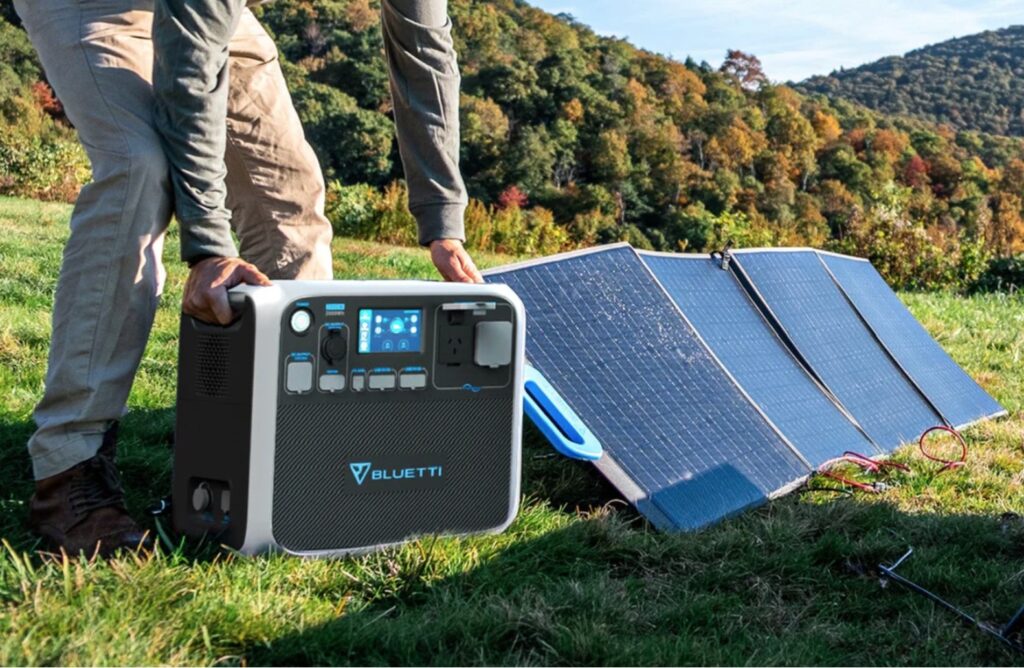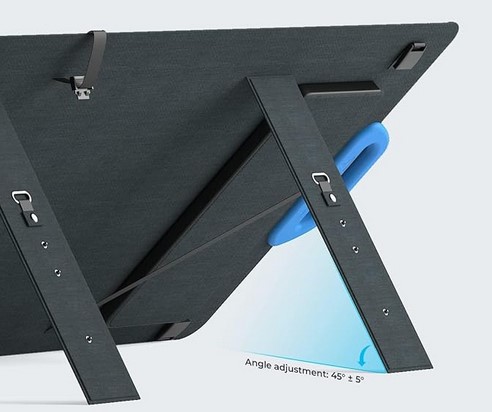The Bluetti PV200 portable solar panel provides up to 200W of power on the go. It is ideal to charge a portable power station.
Forgetting power for the moment, the emphasis here is on portability. It is a foldable, four-panel, monocrystalline silicon (the best) about 60cm square and 75mm deep (2 feet x 3 inches) and unfolded 230 x 60 x 2.5cm, weighing 7.3kg. It comes with a 3m MC4 cable.
While it is easy to quote theoretical manufacturer specifications, we want to see how it performs in different use cases.
Bluetti PV200 Specs
- Maximum peak output (depends on the sun) 20.5V DC/9.7A/198.85W.
- No IP rating – no rain, but handles dew and sand
- The external covering is durable woven nylon and clips.
- The back of one panel has a storage pouch.
- Three fold-out legs (35/45/50°).
- Simply unfold the panels, set them at an east/west orientation, correct tilt angle and connect.
Charging theory 101
Solar panels convert sunlight to DC power. In Australia, the ideal angle to the sun is somewhere between 10-45. Unfortunately, the Bluetti PV200 tilt leg adjustment is not close to that.
Solar panels are inefficient – few achieve a 20% conversion rate – but the PV200 claims up to 23.4% at 25°C and on the ideal angle to the sun. Conversion rates are important, but its four 1.5m2 panels can generate up to 200W, considerably less than a fixed 2m2 solar roof panel that can generate about 400W.
The sun’s efficiency varies throughout the day, affecting wattage and charge time.
The BLUETTI AC60 portable power station – packed with added value features, provides 403 Watt Hours. You would think that a 200W solar panel should fill it in just over 2 hours. Buletti’s claim is 2.5-3 hours. Let’s see.
Australian Review: Bluetti PV200 portable solar panels
| Website | Bluetti Home Page Range Product page User manual |
| Price | $799 |
| Warranty | 2-years ACL |
| From | BLUETTI Online, Harvey Norman, Bunnings and approved retailers. Beware – do not buy internationally sourced products as they will not have RNZ C-Tick certification or local warranty. |
| Made in | China |
| Company | Est. 2019, it is based in Las Vegas, Nevada. BLUETTI stands for BLUE Sky. Tomorrow. Technology. Innovation. It is owned by a Chinese company, Shenzhen PowerOak (Est. 2013). It now supplies to over 70 countries. |
| More | CyberShack portable power station news and reviews |
We use Fail (below expectations), Pass (meets expectations) and Exceed (surpasses expectations or is the class leader) against many of the items below. We occasionally give a Pass(able) rating that is not as good as it should be and a Pass ‘+’ rating to show it is good but does not quite make it to Exceed. You can click on most images for an enlargement.

First Impression – Pass+
We have not reviewed portable solar panels before, so I was pleased to see its relatively compact size and weight. It looks well-made.
Our consumer test panellist’s view says it all.
They both worked fantastically. I was really happy with how they both performed. The Solar panel did a and excellent and fast job charging.
Brad Trower – explorer

Setup – Pass
Find a suitable charging place. Ideally, it needs a 100% clear sky view during daylight hours.
Next, lay the panels on the ground and orient them. Ideally, they should be east/west and north-facing.
Then, tilt the panels. The old rule of thumb is that the best tilt angle is about the same as your latitude – give or take a few degrees. So that varies around Australia from 12.5° in Darwin to 42.9° in Hobart.

You may be surprised how difficult it is to find a suitable placement in suburbia, as homes and trees cast shadows. It is a little easier outdoors, but you must take security precautions like a lock and chain to secure the Bluetti PV200 and portable power station from theft.
Connect to your portable power station or other device with an MPPT controller (maximum power point tracker – an electronic DC to DC converter that optimises the match between the PV panels and the power bank battery). You cannot connect this directly to non-MPPT-equipped devices like e-bikes.

We learned over many weeks of testing that you must regularly check the wattage output (Bluetti AC60 has a meter) and adjust the tilt or orientation for maximum output.
Test 1 – Central Coast NSW 33.5°S latitude
We tested in full sunlight, 20°C, east-west placement, north orientation and 35° tilt (the legs only had 35, 45 and 55° options). Charging took closer to five hours – although the Central Coast where I live is not as sunny as the Sahara, where these test figures obviously come from . The caveat here is that we never saw 200W – our tests showed a maximum of 160W, and most of the time, it was around 70-100W. Hence, five hours is reasonable.
Test 2 – Around Australia heading north from 34-12.5° latitude.
One of our consumer test panellists has it and the Bluetti AC60 on a round Australia 4WD camping trip. Apart from occasional sat phone brief greetings, we got some figures that may be unreliable as he does not have a data logger to record time.
His first comment was that the leg tilt mechanism was flimsy and did not offer a tilt below 35° – he needed 10-30°. There was no way to attach anything to the panels, so he built a 2.3m x 12mm x 3mm aluminium adjustable angle frame that fits on his roof rack or the ground. The raw materials cost about $100 (we have asked for photos), and he Velcros the panels to it.


He reports that in average sunny conditions, 25°C, perfect east/west orientation and 100% view of the sky, a full charge is about four hours. He says that wattage output varies up to 170W but averages 100W. He noticed that charge times increased with the temperature increase.
In cloudy conditions, it is 8-10 hours with wattage generation readings as low as 20-30W. In such conditions, expect an average of 50W.
Summary: You won’t know how fast it is until you try it. Our tester says that overall, he is very happy with the Bluetti AC60, but he really needs a far more powerful Wh power station for camping. Read Portable Power Stations – power on the go (Guide), as incorrect sizing is the biggest issue. He charges it from the 12V DC car socket while driving and uses solar when camping.
He is a little critical of the panel’s long-term durability; its leg system is flimsy and lacks fine adjustment, it can be blown over by wind and has no IP rating.
Build quality – Pass
It is well made for a portable and foldable panel. I have some concerns with the durability of the integrated charge cable, and the handles don’t seem strong enough for their weight. But a 2-year warranty should give you peace of mind.

Use with other power stations?
This is a little theoretical. A 200W solar panel will change power stations requiring up to 20V DC and up to 9.7A. If the power station needs 20V/15A/300W, it charges approximately 30% slower. But if you try and put 200W into a power station that only accepts 100W, it won’t work.
No solar charge controller
The raw output relies on the Bluetti AC60 (or other models) to moderate the power. You should not directly connect this to other devices. Some panels have an in-built MPPT controller/regulator.
CyberShack’s view – Bluetti PV200 portable solar panels are a good idea for those on the go
In so far as it does what it claims – provides up to 200W solar charging, testing shows that the figure is a theoretical maximum. Over four weeks of use, our tester never got within ‘Cooee’ of that. But being realistic, if it can average 100-150W, it is probably as good as other brands’ panels.
Ratings
We have no benchmarks because we have not reviewed portable solar panels before. It would be unfair to Bluetti to give it a rating out of 100.
- Features: Four panels, three prop legs, 3m MC4 charger cable.
- Value: At A$799, it seems expensive, but it is no more expensive than Ecoflow’s 220W Bifacial panel. However, that panel is IP68-rated and almost twice the size.
- Performance: You can count on somewhere between 100-150W in ideal conditions.
- Ease of Use: It is light enough and portable, but the lack of an IP Rating, flimsy legs, and wind issues means you must take care. You should regularly check the AC60 Power station to see if you can maximise charge wattage by moving the panels.
- Design: Well enough designed but needs IP68 and a more solid, adjustable leg system.
Pro
- Portable
- MC4 connector
Con
- It is rated 200W, but the reality is about half that.
- No MPPT controller, so ensure your host device has one.
- Flimsy legs
- It needs a security system if left unattended
- No IP rating











2 comments
Bec
Love reading your off grid product reviews, thank you for detailed descriptions. I would love to ask, to date, what power supply and panels you have chosen to use for yourself ? I trust your judgement 🙂 cheers.
Ray Shaw
Our test panel ended up with the power banks as I ‘work for a living’ and they have time to play (maybe in a few years for me). My best advice is LiFEPo4 batteries only (we only review those) and buy a far bigger capacity than you think you need. The Bluetti AC180 180W/1152Wh $1499, is most attractive in the smaller capacity. During my testing the $2699.95 Anker 757 Powerhouse 1229Wh, 1500/2400 performed best but was way over priced compared to the Bluetti.The Laser NRGVault 1228Wh was also good – the first we reviewed but $1795 is not as attractive as Bluetti. Solar panels are good with the caveat that all test panelists had issues with flimsy construction, wind blowing them over etc. The reasonably priced solution was to build a folding aluminum frame. I see this as a growing category and there are lots of new players. Soon I will go back and update our guide with the benefit of hindsight.